Investigation of an Electrochromic Device Based on Ammonium Metatungstate-Iron (II) Chloride Electrochromic Liquid
Abstract
:1. Introduction
2. Materials and Methods
2.1. Solution Preparation
2.2. Electrochromic Device Preparation
2.3. Performance Characteristics
3. Results and Discussion
3.1. Electrochromic Principle
3.2. Transmission Modulation Amplitude
3.3. Response Time
3.4. Coloring Efficiency
3.5. Cycle Time
4. Conclusions
Supplementary Materials
Author Contributions
Funding
Data Availability Statement
Conflicts of Interest
References
- Wang, Y.; Runnerstrom, E.L.; Milliron, D.J. Switchable materials for smart windows. Annu. Rev. Chem. Biomol. Eng. 2016, 7, 283–304. [Google Scholar] [CrossRef] [PubMed]
- Wang, M.; Xing, X.; Perepichka, I.F.; Shi, Y.; Zhou, D.; Wu, P.; Meng, H. Electrochromic smart windows can achieve an absolute private state through the thermochemically engineered electrolyte. Adv. Energy Mater. 2019, 9, 1900433. [Google Scholar] [CrossRef]
- Zhang, G.; Li, X.; Shi, W.; Wang, B.; Cao, Y. Influence of occupant behavior on the energy performance of variable refrigerant flow systems for office buildings: A case study. J. Build. Eng. 2019, 22, 327–334. [Google Scholar] [CrossRef]
- Sabry, M.; Eames, P.C.; Singh, H.; Wu, Y. Smart windows: Thermal modeling and evaluation. Sol. Energy 2014, 103, 200–209. [Google Scholar] [CrossRef]
- Ke, Y.; Chen, J.; Lin, G.; Wang, S.; Zhou, Y.; Yin, J.; Lee, P.S.; Long, Y. Smart windows: Electro-, thermo-, mechano-, photochromics, and beyond. Adv. Energy Mater. 2019, 9, 1902066. [Google Scholar] [CrossRef]
- Cai, G.; Wang, J.; Lee, P.S. Next-generation multifunctional electrochromic devices. Acc. Chem. Res. 2016, 49, 1469–1476. [Google Scholar] [CrossRef] [PubMed]
- Zhan, Y.; Yang, Z.; Xu, Z.; Hu, Z.; Bai, X.; Ren, Y.; Li, M.; Ullah, A.; Khan, I.; Qiu, J.; et al. Electrochromism induced reversible upconversion luminescence modulation of WO3: Yb3+, Er3+ inverse opals for optical storage application. Chem. Eng. J. 2020, 394, 124967. [Google Scholar] [CrossRef]
- Wang, Z.; Gong, W.; Wang, X.; Chen, Z.; Chen, X.; Chen, J.; Sun, H.; Song, G.; Cong, S.; Geng, F.; et al. Remarkable near-infrared electrochromism in tungsten oxide driven by interlayer water-induced battery-to-pseudocapacitor transition. ACS Appl. Mater. Interfaces 2020, 12, 33917–33925. [Google Scholar] [CrossRef]
- Qian, Y.; Yang, H.; Wang, Y. A novel bis (terpyridine) with π− conjugated phenyl viologen and its metallo-supramolecular polymers: Synthesis and electrochromism. Dye. Pigment. 2020, 176, 108251. [Google Scholar] [CrossRef]
- Huang, Y.; Wang, B.; Chen, F.; Han, Y.; Zhang, W.; Wu, X.; Li, R.; Jiang, Q.; Jia, X.; Zhang, R. Electrochromic Materials Based on Ions Insertion and Extraction. Adv. Opt. Mater. 2022, 10, 2101783. [Google Scholar] [CrossRef]
- Jin, S.; Wen, S.; Li, M.; Zhong, H.; Chen, Y.; Wang, H. Effect of the grain size on the electrochromic properties of NiO films. Opt. Mater. 2020, 109, 110280. [Google Scholar] [CrossRef]
- Deb, S.K. Opportunities and challenges in science and technology of WO3 for electrochromic and related applications. Sol. Energy Mater. Sol. Cells 2008, 92, 245–258. [Google Scholar] [CrossRef]
- Yang, Z.; Pu, H.; Yin, J. Preparation and electrochromic property of covalently bonded WO3/polyvinylimidazole core-shell microspheres. J. Colloid Interface Sci. 2005, 292, 108–112. [Google Scholar] [CrossRef]
- Zhou, Y.; Fan, F.; Liu, Y.; Zhao, S.; Xu, Q.; Wang, S.; Luo, D.; Long, Y. Unconventional smart windows: Materials, structures and designs. Nano Energy 2021, 90, 106613. [Google Scholar] [CrossRef]
- Granqvist, C.G. Electrochromics for smart windows: Oxide-based thin films and devices. Thin Solid Film. 2014, 564, 1–38. [Google Scholar] [CrossRef]
- Wen, R.T.; Granqvist, C.G.; Niklasson, G.A. Eliminating degradation and uncovering ion-trapping dynamics in electrochromic WO3 thin films. Nat. Mater. 2015, 14, 996–1001. [Google Scholar] [CrossRef]
- Granqvist, C.G.; Arvizu, M.A.; Pehlivan, İ.B.; Qu, H.Y.; Wen, R.T.; Niklasson, G.A. Electrochromic materials and devices for energy efficiency and human comfort in buildings: A critical review. Electrochim. Acta 2018, 259, 1170–1182. [Google Scholar] [CrossRef]
- Baetens, R.; Jelle, B.P.; Gustavsen, A. Properties, requirements and possibilities of smart windows for dynamic daylight and solar energy control in buildings: A state-of-the-art review. Sol. Energy Mater. Sol. Cells 2010, 94, 87–105. [Google Scholar] [CrossRef]
- Yu, H.; Qi, M.; Wang, J.; Yin, Y.; He, Y.; Meng, H.; Huang, W. A feasible strategy for the fabrication of camouflage electrochromic fabric and unconventional devices. Electrochem. Commun. 2019, 102, 31–36. [Google Scholar] [CrossRef]
- Qiu, T.; Luo, B.; Liang, M.; Ning, J.; Wang, B.; Li, X.; Zhi, L. Hydrogen reduced graphene oxide/metal grid hybrid film: Towards high performance transparent conductive electrode for flexible electrochromic devices. Carbon 2015, 81, 232–238. [Google Scholar] [CrossRef]
- Pandurangarao, K.; Purnachand, N.; Kumar, V.R. Studies on magnetron sputtered deposited nanocrystalline tungsten oxide films useful for electrochromic devices. Opt. Mater. 2020, 101, 109791. [Google Scholar] [CrossRef]
- Yao, Y.; Zhao, Q.; Wei, W.; Chen, Z.; Zhu, Y.; Zhang, P.; Zhang, Z.; Gao, Y. WO3 quantum-dots electrochromism. Nano Energy 2020, 68, 104350. [Google Scholar] [CrossRef]
- Liu, L.; Layani, M.; Yellinek, S.; Kamyshny, A.; Ling, H.; Lee, P.S.; Magdassi, S.; Mandler, D. “Nano to nano” electrodeposition of WO3 crystalline nanoparticles for electrochromic coatings. J. Mater. Chem. A 2014, 2, 16224–16229. [Google Scholar] [CrossRef]
- Ou, J.Z.; Balendhran, S.; Field, M.R.; McCulloch, D.G.; Zoolfakar, A.S.; Rani, R.A.; Zhuiykov, S.; O’Mullane, A.P.; Kalantar-Zadeh, K. The anodized crystalline WO3 nanoporous network with enhanced electrochromic properties. Nanoscale 2012, 4, 5980–5988. [Google Scholar] [CrossRef]
- Cong, S.; Tian, Y.; Li, Q.; Zhao, Z.; Geng, F. Single-crystalline tungsten oxide quantum dots for fast pseudocapacitor and electrochromic applications. Adv. Mater. 2014, 26, 4260–4267. [Google Scholar] [CrossRef]
- Cai, G.; Darmawan, P.; Cheng, X.; Lee, P.S. Inkjet printed large area multifunctional smart windows. Adv. Energy Mater. 2017, 7, 1602598. [Google Scholar] [CrossRef]
- Zhang, G.; Zhang, J.; Qiu, T.; Ning, H.; Fang, Z.; Zhong, J.; Yang, Y.; Yao, R.; Luo, D.; Peng, J. Fabrication of flexible electrochromic film based on amorphous isopolytungstate by low-temperature inkjet-printed process with a solution crystallization kinetic-controlled strategy. Chem. Eng. J. 2022, 427, 131840. [Google Scholar] [CrossRef]
- Tahara, H.; Baba, R.; Iwanaga, K.; Sagara, T.; Murakami, H. Electrochromism of a bipolar reversible redox-active ferrocene–viologen linked ionic liquid. Chem. Commun. 2017, 53, 2455–2458. [Google Scholar] [CrossRef]
- Gumerova, N.I.; Rompel, A. Synthesis, structures and applications of electron-rich polyoxometalates. Nat. Rev. Chem. 2018, 2, 0112. [Google Scholar] [CrossRef]
- Launay, J.P. Reduction de l’ion metatungstate: Stades eleves de reduction de H2W12O406−, derives de l’ion HW12O407− et discussion generale. J. Inorg. Nucl. Chem. 1976, 38, 807–816. [Google Scholar] [CrossRef]
- Miras, H.N.; Yan, J.; Long, D.L.; Cronin, L. Engineering polyoxometalates with emergent properties. Chem. Soc. Rev. 2012, 41, 7403–7430. [Google Scholar] [CrossRef] [PubMed]
- Zhang, W.; Li, H.; Hopmann, E.; Elezzabi, A.Y. Nanostructured inorganic electrochromic materials for light applications. Nanophotonics 2021, 10, 825–850. [Google Scholar] [CrossRef]
- Zhang, B.; Xu, G.; Tan, S.; Liu, C. Effects of indium-doped tin oxide film on electrochromic properties under lithium ion guidance. Opt. Mater. 2020, 101, 109756. [Google Scholar] [CrossRef]
- Kadir MF, Z.; Majid, S.R.; Arof, A.K. Plasticized chitosan–PVA blend polymer electrolyte-based proton battery. Electrochim. Acta 2010, 55, 1475–1482. [Google Scholar] [CrossRef]
- Lee, J.H.; Ryu, J.B.; Lee, A.S.; Na, W.; Yoon, H.S.; Kim, W.J.; Koo, C.M. High-voltage ionic liquid electrolytes based on ether functionalized pyrrolidinium for electric double-layer capacitors. Electrochim. Acta 2016, 222, 1847–1852. [Google Scholar] [CrossRef]
- Zhang, B.; Xu, C.; Xu, G.; Tan, S.; Zhang, J. Amorphous titanium dioxide film with improved electrochromism in near-infrared region. Opt. Mater. 2019, 89, 191–196. [Google Scholar] [CrossRef]
- Chen, H.C.; Jan, D.J.; Chen, C.H.; Huang, K.T. Bond and electrochromic properties of WO3 films deposited with horizontal DC, pulsed DC, and RF sputtering. Electrochim. Acta 2013, 93, 307–313. [Google Scholar] [CrossRef]
- Li, K.; Zhang, Q.; Wang, H.; Li, Y. Lightweight, highly bendable and foldable electrochromic films based on all-solution-processed bilayer nanowire networks. J. Mater. Chem. C 2016, 4, 5849–5857. [Google Scholar] [CrossRef]
- Chen, H.C.; Jan, D.J.; Chen, C.H. Investigation of optical and electrochromic properties of tungsten oxide deposited with horizontal DC and DC pulse magnetron sputtering. Jpn. J. Appl. Phys. 2012, 51, 045503. [Google Scholar] [CrossRef]
- Zhang, S.; Cao, S.; Zhang, T.; Fisher, A.; Lee, J.Y. Al3+ intercalation/de-intercalation-enabled dual-band electrochromic smart windows with a high optical modulation, quick response and long cycle life. Energy Environ. Sci. 2018, 11, 2884–2892. [Google Scholar] [CrossRef]
- Zhao, Y.; Zhang, X.; Li, W.; Li, Z.; Zhang, H.; Chen, M.; Sun, W.; Xiao, Y.; Zhao, J.; Li, Y. High-performance electrochromic WO3 film driven by controllable crystalline structure and its all-solid-state device. Sol. Energy Mater. Sol. Cells 2022, 237, 111564. [Google Scholar] [CrossRef]
- Qiu, D.; Ji, H.; Zhang, X.; Zhang, H.; Cao, H.; Chen, G.; Tian, T.; Chen, Z.; Guo, X.; Liang, L.; et al. Electrochromism of nanocrystal-in-glass tungsten oxide thin films under various conduction cations. Inorg. Chem. 2019, 58, 2089–2098. [Google Scholar] [CrossRef] [PubMed]
- Joraid, A.A.; Alamri, S.N. Effect of annealing on structural and optical properties of WO3 thin films prepared by electron-beam coating. Phys. B Condens. Matter 2007, 391, 199–205. [Google Scholar] [CrossRef]
- Oka, N.; Watanabe, M.; Sugie, K.; Iwabuchi, Y.; Kotsubo, H.; Shigesato, Y. Reactive-gas-flow sputter deposition of amorphous WO3 films for electrochromic devices. Thin Solid Film. 2013, 532, 1–6. [Google Scholar] [CrossRef]
- Guo, J.; Wang, M.; Diao, X.; Zhang, Z.; Dong, G.; Yu, H.; Liu, F.; Wang, H.; Liu, J. Prominent electrochromism achieved using aluminum ion insertion/extraction in amorphous WO3 films. J. Phys. Chem. C 2018, 122, 19037–19043. [Google Scholar] [CrossRef]
- Liang, L.; Zhang, J.; Zhou, Y.; Xie, J.; Zhang, X.; Guan, M.; Pan, B.; Xie, Y. High-performance flexible electrochromic device based on facile semiconductor-to-metal transition realized by WO3·2H2O ultrathin nanosheets. Sci. Rep. 2013, 3, 1936. [Google Scholar] [CrossRef]
- Wang, Z.; Sun, K.; Xie, P.; Liu, Y.; Gu, Q.; Fan, R. Permittivity transition from positive to negative in acrylic polyurethane-aluminum composites. Compos. Sci. Technol. 2020, 188, 107969. [Google Scholar] [CrossRef]
- Tong, Z.; Kang, T.; Wan, Y.; Yang, R.; Wu, Y.; Shen, D.; Liu, S.; Tang, Y.; Lee, C.S. A Ca-Ion Electrochromic Battery via a Water-in-Salt Electrolyte. Adv. Funct. Mater. 2021, 31, 2104639. [Google Scholar] [CrossRef]
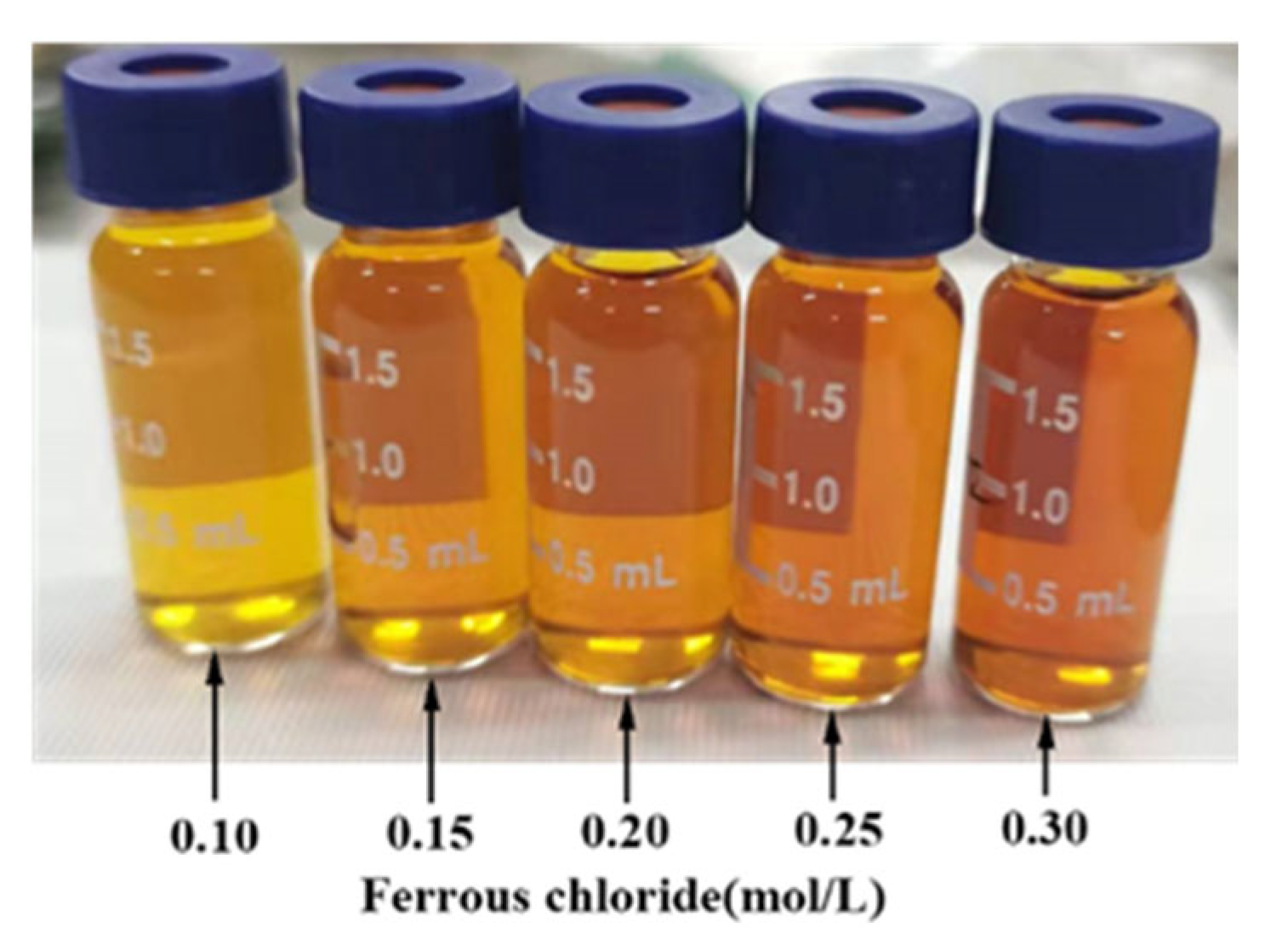
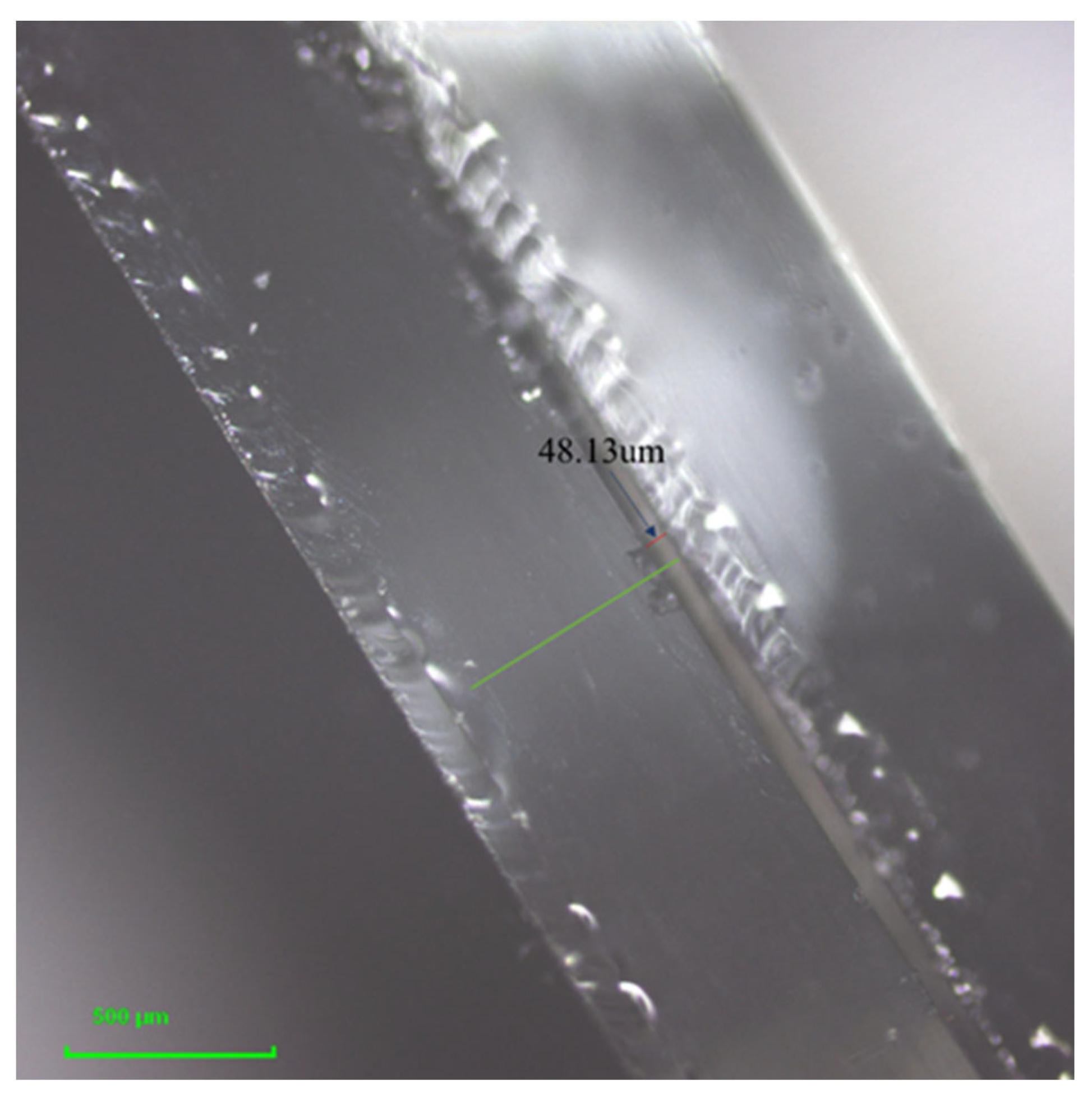
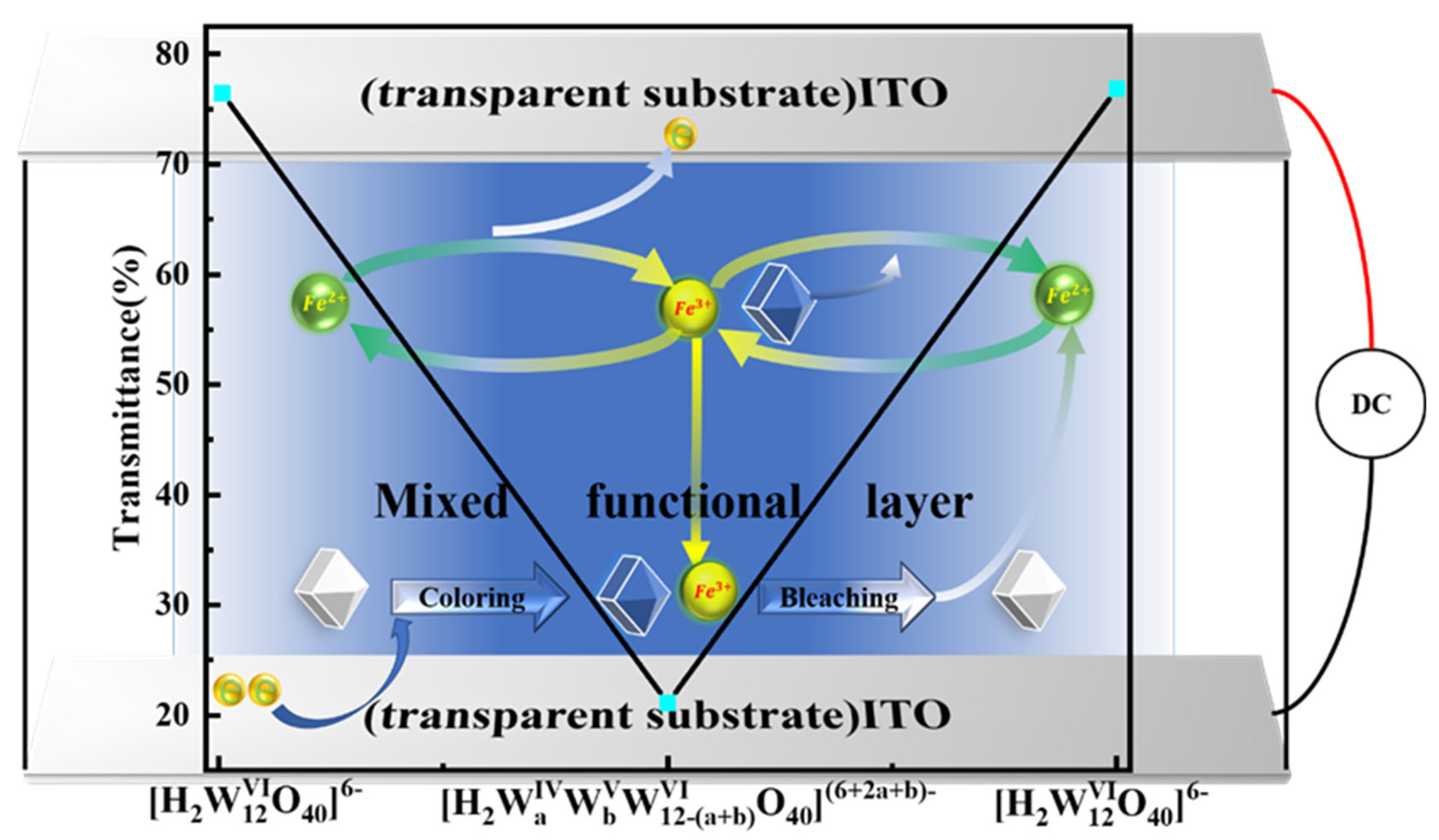
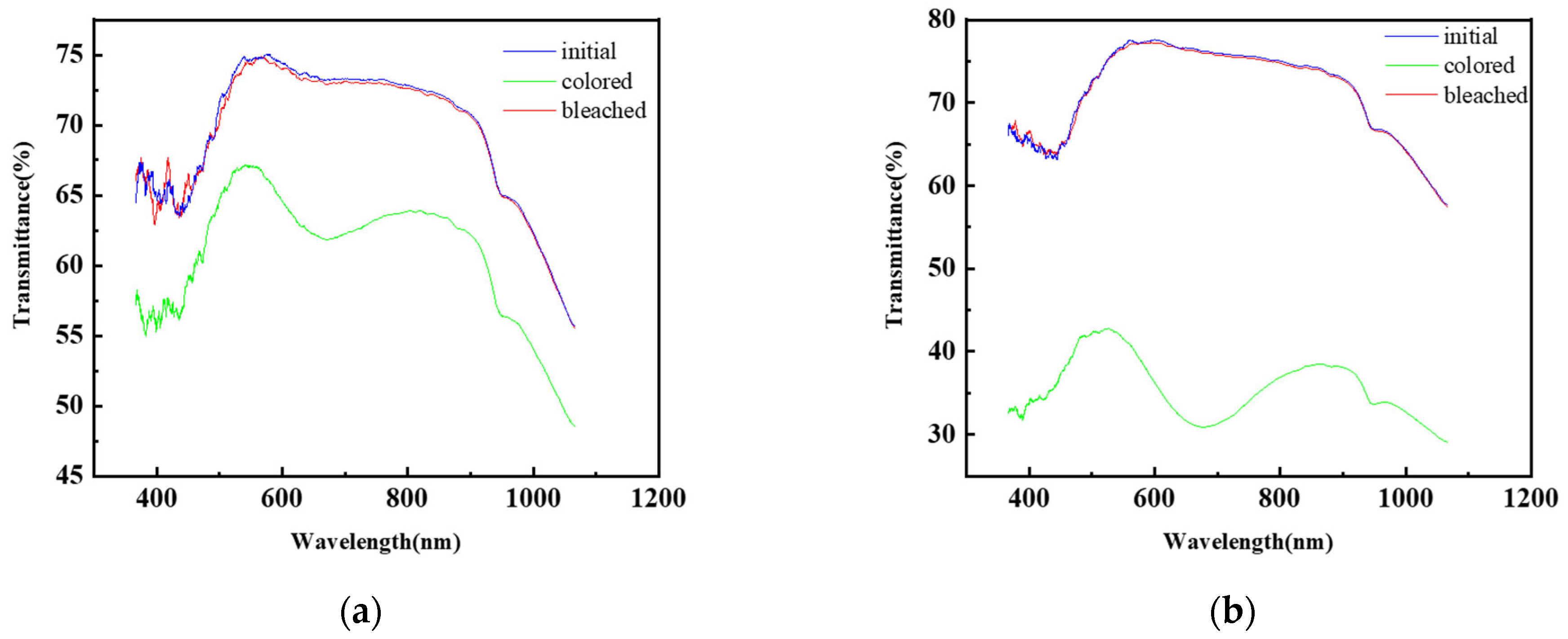



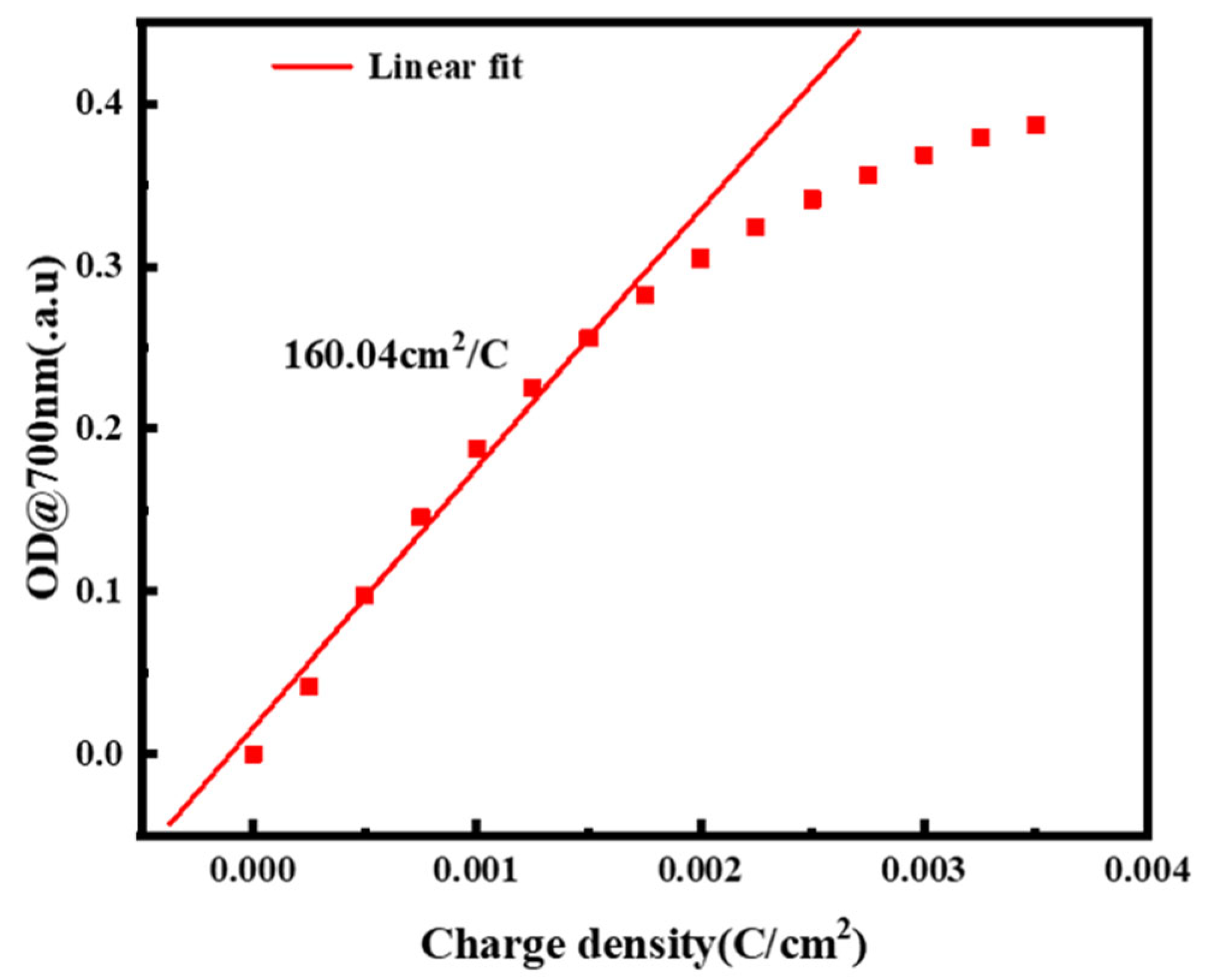


| Code Number | Ammonium Metatungstate (mol/L) | Current Density (A/m2) | Iron (II) Chloride (mol/L) |
|---|---|---|---|
| #1 | 0.100 | 1 | 0.10 |
| #2 | 0.100 | 2 | 0.15 |
| #3 | 0.100 | 3 | 0.20 |
| #4 | 0.100 | 4 | 0.25 |
| #5 | 0.100 | 5 | 0.30 |
| #6 | 0.125 | 1 | 0.15 |
| #7 | 0.125 | 2 | 0.20 |
| #8 | 0.125 | 3 | 0.25 |
| #9 | 0.125 | 4 | 0.30 |
| #10 | 0.125 | 5 | 0.10 |
| #11 | 0.150 | 1 | 0.20 |
| #12 | 0.150 | 2 | 0.25 |
| #13 | 0.150 | 3 | 0.30 |
| #14 | 0.150 | 4 | 0.10 |
| #15 | 0.150 | 5 | 0.15 |
| #16 | 0.175 | 1 | 0.25 |
| #17 | 0.175 | 2 | 0.30 |
| #18 | 0.175 | 3 | 0.10 |
| #19 | 0.175 | 4 | 0.15 |
| #20 | 0.175 | 5 | 0.20 |
| #21 | 0.200 | 1 | 0.30 |
| #22 | 0.200 | 2 | 0.10 |
| #23 | 0.200 | 3 | 0.15 |
| #24 | 0.200 | 4 | 0.20 |
| #25 | 0.200 | 5 | 0.25 |
| Materials | Film Preparation Method | ΔT (%) | Reference |
|---|---|---|---|
| Ammonium Metatungstate–Iron (II) Chloride | None—film | 57% (700 nm) | This work |
| WO3 | RF magnetron sputtering | 57% (633 nm) | [37] |
| WO3/PEDOT | Spray coating | 48% (633 nm) | [38] |
| WO3 | DC magnetron sputtering | 57% (550 nm) | [39] |
| Materials | Film Preparation Method | Response Time(s) tb/tc | Reference |
|---|---|---|---|
| Ammonium Metatungstate–iron (II) chloride | None—film | 8.5/6 | This work |
| m-WO3-x nanowires | Spin coating | 16/13 | [40] |
| WO3 | Magnetron sputtering | 4.0/7.1 | [41] |
| WO3 (nanocrystals embedded in the amorphous matrix) Ammonium metatungstate (ethylene glycol and ammonium hydroxide) | Electron beam evaporation Inkjet print | 12/12 2.8/10.4 | [42] [27] |
| Materials | Film Preparation Method | CE (cm2/C) | Reference |
|---|---|---|---|
| Ammonium metatungstate–iron (II) chloride | / | 160.04 cm2/C | This work |
| WO3 | RF magnetron sputtering | 27.7 cm2/C | [37] |
| WO3 | Electrodeposition | 51 cm2/C | [23] |
| WO3 | Reactive-gas-flow sputtering | 35 cm2/C | [44] |
| WO3 (amorphous) WO3·2H2O (nanosheets) | Sputtering Filtration | 72 cm2/C 120.9 cm2/C | [45] [46] |
Publisher’s Note: MDPI stays neutral with regard to jurisdictional claims in published maps and institutional affiliations. |
© 2022 by the authors. Licensee MDPI, Basel, Switzerland. This article is an open access article distributed under the terms and conditions of the Creative Commons Attribution (CC BY) license (https://creativecommons.org/licenses/by/4.0/).
Share and Cite
Kong, S.; Zhang, G.; Li, M.; Yao, R.; Guo, C.; Ning, H.; Zhang, J.; Tao, R.; Yan, H.; Lu, X. Investigation of an Electrochromic Device Based on Ammonium Metatungstate-Iron (II) Chloride Electrochromic Liquid. Micromachines 2022, 13, 1345. https://doi.org/10.3390/mi13081345
Kong S, Zhang G, Li M, Yao R, Guo C, Ning H, Zhang J, Tao R, Yan H, Lu X. Investigation of an Electrochromic Device Based on Ammonium Metatungstate-Iron (II) Chloride Electrochromic Liquid. Micromachines. 2022; 13(8):1345. https://doi.org/10.3390/mi13081345
Chicago/Turabian StyleKong, Sifan, Guanguang Zhang, Muyun Li, Rihui Yao, Chenxiao Guo, Honglong Ning, Jianzhi Zhang, Ruiqiang Tao, Haoyang Yan, and Xubing Lu. 2022. "Investigation of an Electrochromic Device Based on Ammonium Metatungstate-Iron (II) Chloride Electrochromic Liquid" Micromachines 13, no. 8: 1345. https://doi.org/10.3390/mi13081345
APA StyleKong, S., Zhang, G., Li, M., Yao, R., Guo, C., Ning, H., Zhang, J., Tao, R., Yan, H., & Lu, X. (2022). Investigation of an Electrochromic Device Based on Ammonium Metatungstate-Iron (II) Chloride Electrochromic Liquid. Micromachines, 13(8), 1345. https://doi.org/10.3390/mi13081345







